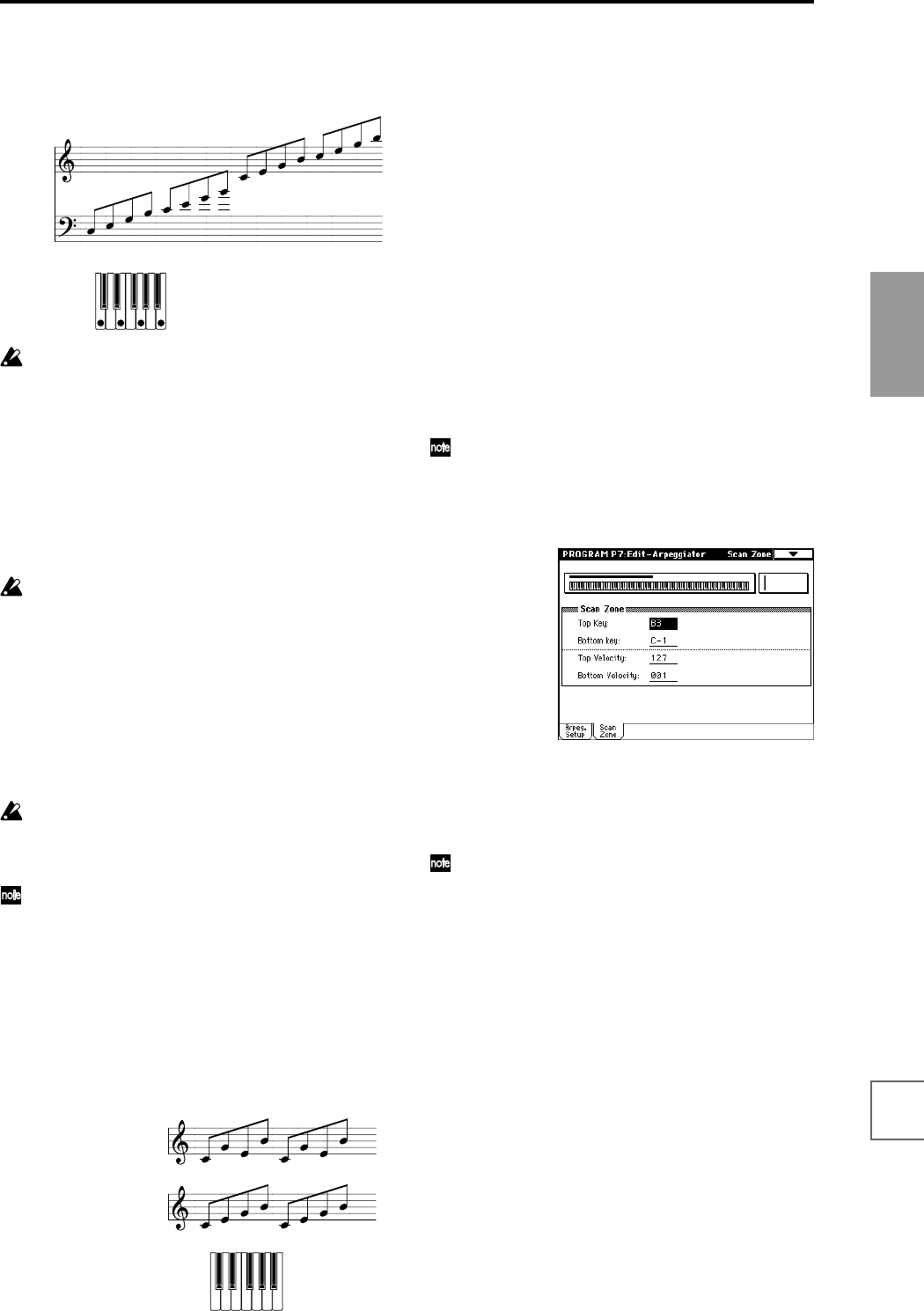
131
Basic functions
Saving dataLoading dataProgram
settings
Combination
settings
Producing
songs
Sampling
settings
Creating a
CD
SMF
playback
System
settings
Drum kit
settings
Arpeggiator
settings
Effects
settings
Other
functions
4 Adjust the settings of the various parameters.
“Octave”: Selects the octave range in which the arpeg-
gio will be played.
If a user arpeggio pattern is selected, the “Octave
Motion” setting (Global P6: Arpeggio, Pattern Setup
page) will affect the way in which the arpeggio is
played.
“Resolution”: Specifies the timing value of the arpeg-
gio notes over a range of 3 – .
“Gate”: Specifies the length (gate time) of each note in
the arpeggio. If a user arpeggio pattern is selected, you
can set this to Step. In this case, the value of the “Gate”
setting for each step (Global P6: User Arpeggio, Pattern
Edit page) will be used.
This value will be in effect when the ARPEGGIATOR
[GATE] knob is in the center position (12 o’clock). Be
sure that the knob is in the center position when you
make this setting.
“Velocity”: Specifies the velocity of the notes in the
arpeggio. If this is set to Key, the velocity with which
you actually played each note will be used. If a user
arpeggio pattern is selected, you can set this to Step. In
this case, the value of the “Vel” setting for each step
(Global P6: User Arpeggio, Pattern Edit page) will be
used.
This value will be in effect when the ARPEGGIATOR
[VELOCITY] knob is in the center position (12
o’clock). Be sure that the knob is in the center position
when you make this setting.
When a preload user arpeggio pattern is selected, set-
ting the “Gate” or “Velocity” to Step will add a sense
of groove to the arpeggio pattern.
“Swing”: This adjusts the timing of the even-num-
bered notes in the arpeggio (counting from the first
note), to give the pattern a sense of “swing.”
“Sort”: If this is checked, the arpeggio will be sounded
in order of pitch, regardless of the order in which notes
were played on keyboard (On). If this is unchecked,
the arpeggio will be sounded in the order in which the
notes were played on keyboard (Off).
“Latch”: If this is checked, the arpeggio will continue
playing even after you take your hand off the key-
board. If this is unchecked, the arpeggio will stop play-
ing when you take your hand off the keyboard.
“Key Sync.”: If this is checked, the arpeggio pattern
will start from the beginning when you play a note
after having released all notes. This setting is suitable
when you are playing in realtime, and want the arpeg-
gio to start at the beginning of the measure. If this is
unchecked, the arpeggio pattern will always be syn-
chronized to the tempo of the MIDI clock. For details
on synchronization, refer to “Synchronizing the arpeg-
giator” (☞p.138).
“Keyboard”: If this is checked, the notes you play on
the keyboard will be heard as well as the arpeggiated
notes. If this is unchecked, only the arpeggiated notes
will be heard.
The same setting can be made by editing the parameter
of the same name (or abbreviation) in the Program P0:
Play, Arpeggio page.
You can use the page menu command “Copy Arpeg-
giator” to copy arpeggiator settings from another
program or combination (☞PG p.27).
5 In the Scan Zone page, specify the range in which the
arpeggiator will operate.
“Bottom Key,” “Top Key”: The arpeggiator will oper-
ate when you play keys within the specified range.
Keys outside of this range can be played in the normal
manner, and will not be affected by the arpeggiator
on/off.
For example if you set “Pattern” to P000: UP, check
“Latch,” set “Top Key” to B3, and “Bottom Key” to
C-1, playing a note B3 or lower will trigger the arpeg-
giator. Since “Latch” is on, the arpeggio will continue
even after you release the keys. You can use the C4
and higher keys to play conventionally along with
the arpeggio sounded by the B3 and lower keys. To
change the arpeggio, play keys in the range of B3 and
below.
“Bottom Velocity” “Top Velocity”: The arpeggiator will
operate when you play notes with a velocity (playing
strength) that is within the specified range. Notes played
with a velocity outside this range will be sounded nor-
mally, without regard to the arpeggiator on/off.
6 If you wish to save the edited program settings to
internal memory, turn off memory protect in Global
mode, and write the program (☞p.57).
Linking the arpeggiator to a program
If you want the arpeggiator settings written in a program
to be selected when that program is selected, check Pro-
gram for “Auto Arpeggiator” (Global P0: Basic Setup,
Basic page).
Octave: 4
UP
ON, UP
Sort
OFF, UP
Sort


















